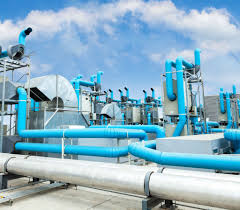
Industrial Air Conditioning Solutions in Australia: A Complete Guide for Businesses
Introduction: Why Industrial Air Conditioning Matters
[the-post-grid id=”829″ title=”Grid 1″]Industrial air conditioning solutions in Australia do far more than just cool large spaces—they are essential for maintaining operational efficiency, protecting sensitive equipment, and ensuring a comfortable, compliant working environment. Whether you manage a warehouse, manufacturing plant, data centre, or large commercial facility, selecting the right industrial HVAC system is crucial for consistent temperature control, energy efficiency, and workplace safety.
In this comprehensive guide, we’ll explore:
-
The top industrial air conditioning solutions in Australia
-
How to choose the best system for your business
-
The role of energy efficiency and cost savings
-
Common industrial HVAC challenges and how to resolve them
-
Leading industrial HVAC providers in Australia
1. Understanding Industrial Air Conditioning Solutions
Industrial air conditioning systems are designed to meet the high demands of large-scale operations. Unlike residential or small commercial systems, these solutions offer advanced features for performance, durability, and efficiency.
Key Characteristics of Industrial HVAC Systems:
-
High Capacity: Built to cool expansive areas with significant heat loads
-
Advanced Technology: Includes VRF (Variable Refrigerant Flow), zoning, and automation
-
Durability: Engineered for 24/7 operation in extreme conditions
1.1 Ducted Air Conditioning Systems
Best for: Warehouses, shopping centres, multi-level office buildings
Features: Centralised cooling via a network of ducts
Pros:
-
Uniform temperature distribution
-
Ideal for multi-storey buildings
-
Smart thermostat compatibility for enhanced control
1.2 Evaporative Cooling Systems
Best for: Factories, warehouses, open-plan workshops
Features: Uses water evaporation to cool the air
Pros:
-
Low electricity consumption
-
Eco-friendly and reduces carbon footprint
-
Enhances indoor air quality
Cons:
-
Ineffective in humid climates
-
Requires routine maintenance of water systems
1.3 VRF (Variable Refrigerant Flow) Systems
Best for: Data centres, hospitals, large offices
Features: Provides precise zoning with multiple indoor units connected to one outdoor unit
Pros:
-
Highly energy-efficient
-
Flexible installation options
-
Advanced temperature control
1.4 Chiller Systems (Air-Cooled & Water-Cooled)
Best for: Industrial manufacturing plants, large-scale operations, healthcare facilities
Features: Removes heat through either air or water-cooled chillers
Pros:
-
Scalable for large applications
-
Long-lasting and reliable
-
Can integrate into existing HVAC setups
Cons:
-
Higher upfront cost
-
Requires professional maintenance
1.5 Split System Air Conditioning
Best for: Server rooms, control rooms, small industrial spaces
Features: Independent cooling units for specific zones
Pros:
-
Lower installation and maintenance costs
-
Ideal for spot cooling
-
Simple to operate and maintain
2. Choosing the Right Cooling Solution for Your Business
Finding the right HVAC system involves assessing your operational requirements and the physical characteristics of your facility.
2.1 Key Factors to Consider
-
Facility Size & Layout: Large open areas benefit from ducted or chiller systems, while smaller zones may require split systems.
-
Energy Efficiency Ratings: Look for systems with high SEER (Seasonal Energy Efficiency Ratio) ratings.
-
Local Climate: In humid areas, avoid evaporative coolers.
-
Operational Hours: 24/7 facilities need systems with high durability and reliability.
-
Compliance: Systems must adhere to AS/NZS 1668.2 standards for ventilation and indoor air quality.
3. Maximising Energy Efficiency & Reducing HVAC Costs
Reducing operational costs starts with investing in efficient HVAC technologies and implementing smart energy-saving practices.
3.1 Choose Energy-Efficient Systems
-
VRF & Chiller Units: Use inverter technology to modulate cooling demand
-
Refrigerants: Select eco-friendly options like R32 and R410A to reduce environmental impact
3.2 Optimise System Operations
-
Use smart thermostats to minimise waste
-
Operate systems during off-peak hours to benefit from lower energy rates
-
Implement zoned cooling to avoid unnecessary energy consumption
3.3 Take Advantage of Government Incentives
Businesses upgrading to energy-efficient HVAC systems may qualify for rebates, including:
-
Energy Efficiency Grants for SMEs
-
Commercial Building Disclosure (CBD) Program
Visit energy.gov.au to explore current incentives and grants.
4. Common Industrial HVAC Challenges (and How to Fix Them)
Even top-tier HVAC systems can face issues if not properly maintained. Here’s how to address common industrial air conditioning problems:
4.1 Uneven Cooling and Hot Spots
Solution: Install zoned cooling systems like VRF or ducted units with dampers to balance airflow.
4.2 High Energy Bills
Solution: Upgrade to energy-efficient systems, integrate smart controls, and schedule regular maintenance to improve system performance.
4.3 Poor Air Quality and Ventilation
Solution: Install HEPA filters, clean ducts regularly, and use air purifiers to improve air quality.
4.4 Equipment Downtime
Solution: Preventive maintenance is key. Schedule regular servicing and use high-quality refrigerants and parts to reduce system breakdowns.
5. Top Industrial HVAC Providers in Australia
Choosing a reputable provider ensures proper installation, ongoing support, and long-term reliability. Here are Australia’s most trusted industrial HVAC brands:
5.1 Leading HVAC Companies in Australia
-
Daikin Australia – Experts in VRF and ducted systems for large-scale facilities
-
Mitsubishi Electric – Known for high-efficiency air conditioning solutions
-
ActronAir – Australian-made systems designed for extreme local conditions
-
Fujitsu General Australia – Specialises in reliable cooling for tough industrial environments
6. Conclusion: Find the Right HVAC System for Your Business
The right industrial air conditioning system can improve your business’s productivity, reduce operating costs, and ensure compliance with Australian standards.
Key Takeaways:
-
Choose a system based on your facility’s size, layout, and cooling needs
-
Prioritise energy efficiency and long-term savings
-
Work with trusted HVAC professionals for system selection and installation
-
Stay compliant with industry regulations and maintain air quality standards
📞 Need Expert HVAC Advice?
Contact Efficient Refrigeration and HVAC today for a free industrial cooling consultation. We’ll help you choose the most efficient, cost-effective, and compliant solution tailored to your business.
👉 Visit eres.net.au to learn more or book your consultation.


